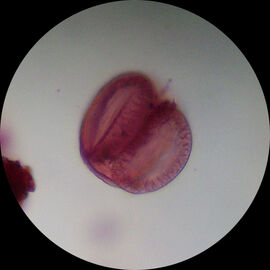
Pollen under microscope
Palynology is the science that studies contemporary and fossil palynomorphs, including pollen, spores, dinoflagellate cysts, acritarchs, chitinozoans and scolecodonts, together with particulate organic matter (POM) and kerogen found in sedimentary rocks and sediments.
The term palynology was introduced by Hyde and Williams in 1944, following correspondence with the Swedish geologist Antevs, in the pages of the Pollen Analysis Circular (one of the first journals devoted to pollen analysis, and produced by Paul Sears in North America). Hyde and Williams chose palynology on the basis of the Greek words paluno meaning 'to sprinkle' and pale meaning 'dust' (and thus similar to the Latin word pollen).
Palynology is an interdisciplinary science and is a branch of earth science (geology or geological science) and biological science (biology), particularly plant science (botany). Stratigraphical palynology is a branch of micropalaeontology and paleobotany which studies fossil palynomorphs from the Precambrian to the Holocene.
Methods of study
Palynomorphs are broadly defined as organic-walled microfossils between 5 and 500 micrometres in size. They are extracted from rocks and sediments both physically, by wet sieving, often after ultrasonic treatment, and chemically, by using chemical digestion to remove the non-organic fraction. For example, palynomorphs may be extracted using hydrochloric acid (HCl) to digest carbonate minerals, and hydrofluoric acid (HF) to digest silicate minerals in suitable fume cupboards in specialist laboratories.
Samples are then mounted on microscope slides and examined using light microscopy or scanning electron microscopy. Once the pollen grains have been identified they can be plotted on a pollen diagram which is then used for interpretation. Pollen diagrams are useful in giving evidence of past human activity (anthropogenic impact), vegetation history and climatic history.
Palynology uses many techniques from other related fields such as geology, botany, paleontology, archaeology, pedology, and geography.
Applications
Palynology is used for a diverse range of applications, related to many scientific disciplines:
- Biostratigraphy and geochronology. Geologists use palynological studies in biostratigraphy to correlate strata and determine the relative age of a given bed, horizon, formation or stratigraphical sequence.
- Palaeoecology and climate change. Palynology can be used to reconstruct past vegetation (land plants) and marine and freshwater phytoplankton communities, and so infer past environmental (palaeoenvironmental) and palaeoclimatic conditions.
- Organic palynofacies studies, which examine the preservation of the particulate organic matter and palynomorphs provides information on the depositional environment of sediments and depositional palaeoenvironments of sedimentary rocks.
- Geothermal alteration studies examine the colour of palynomorphs extracted from rocks to give the thermal alteration and maturation of sedimentary sequences, which provides estimates of maximum palaeotemperatures.
- Limnology studies. Freshwater palynomorphs and animal and plant fragments, including the prasinophytes and desmids (green algae) can be used to study past lake levels and long term climate change.
- Taxonomy and evolutionary studies.
- Forensic palynology- the study of pollen and other palynomorphs for evidence at a crime scene.
- Allergy studies. Studies of the geographic distribution and seasonal production of pollen, can help sufferers of allergies such as hay fever.
- Melissopalynology - the study of pollen and spores found in honey.
- Archaeological Palynology examines human uses of plants in the past. This can help determine seasonality of site occupation, presence or absence of agricultural practices or products and plant-related activity areas within an archaeological context. Bonfire Shelter is one such example of this application.
Because the distribution of acritarchs, chitinozoans, dinoflagellate cysts, pollen and spores provides evidence of stratigraphical correlation through biostratigraphy and palaeoenvironmental reconstruction, one common and lucrative application of palynology is in oil and gas exploration.
Palynology also allows scientists to infer the climatic conditions from the vegetation present in an area thousands or millions of years ago. This is a fundamental part of research into climate change.
References
- Moore, P.D., et al. (1991), Pollen Analysis (Second Edition). Blackwell Scientific Publications. ISBN 0-632-02176-4
- Traverse, A. (1988), Paleopalynology. Unwin Hyman ISBN 0-04-561001-0
External links
- International Federation of Palynological Societies
- American Association of Stratigraphic Palynologists, Inc. (AASP)
- Centre for Palynology, University of Sheffield, UK
- Palynology Laboratory, French Institute of Pondicherry, India
- The Palynology Unit, Kew Gardens, UK
- PalDat, palynological database hosted by the University of Vienna, Austria
- The Micropalaeontological Society
- The American Association of Stratigraphic Palynologists (AASP)
- Commission Internationale de Microflore du Paléozoique (CIMP), international commission for Palaeozoic palynology.
- CIMP Subcommission on Acritarchs
- CIMP Chitinozoan Subcommission
- Linnean Society Palynology Specialist Group (LSPSG)
- Canadian Association of Palynologists
- Pollen and Spore Identification Literature